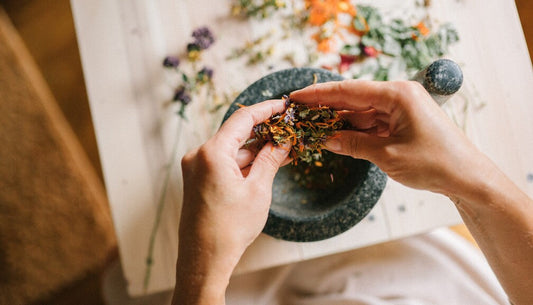Leaves cover the ground, school buses dot the roads, and there’s a crisp chill in the air. These are all signs that Vata season is upon us. If you’re a Vata type, you may have a history of getting sick with colds, sore throats, or the flu in the fall. And the media’s warnings of impending flu and cold viruses might have you running for cover. With Ayurveda, however, you can arm yourself with the tools you need to stay healthy and balanced throughout the season.
The Doshas, or Ayurvedic mind-body types, are not only found in each of us, they also exist in nature. In most of the Northern Hemisphere, Vata season tends to be in late fall to early winter. If you think about the elements that make up Vata—space and air—they’re also increased in nature during this season. The air is growing cooler, and the leaves are drying out and falling off the trees. The wind tends to pick up unexpectedly, and because of the wind, the air is dry.
If your primary dosha is Vata, space and air will increase even more during Vata season. Since you don’t need more of what you already have, this increase will create discomfort in the body and leave you susceptible to illness if you don’t keep it under control.
Because of the increased air quality in the atmosphere, you may find that your hair, skin, and eyes are drier than ever before. This is because you have more space and air in your mind-body constitution than a Pitta or Kapha type. Vata types also have a tendency to feel cold and have cold hands and feet. They may also experience constipation and dry stools. In the mind, the Vata type may feel nervous or anxious and have trouble sleeping. These symptoms, while in balance during other seasons, may become exaggerated during Vata season.
The trouble with an aggravated Dosha is not just the symptoms it can cause. When a Dosha becomes too elevated, it begins to travel to other parts of the body where it doesn’t belong. And that is where the seeds of illness can implant and start to grow. The good news is that there are some simple things you can do to pacify Vata in the fall.
Make sure you keep your insides lubricated too by eating food that has healthy fats, adding a little olive oil when appropriate, and perhaps taking a tablespoon of fresh flaxseed oil during the fall days. Flaxseed oil will help keep you regular and is high in Omega-3 fatty acids, which may help lower Vata anxiety or nervousness.
The Doshas, or Ayurvedic mind-body types, are not only found in each of us, they also exist in nature. In most of the Northern Hemisphere, Vata season tends to be in late fall to early winter. If you think about the elements that make up Vata—space and air—they’re also increased in nature during this season. The air is growing cooler, and the leaves are drying out and falling off the trees. The wind tends to pick up unexpectedly, and because of the wind, the air is dry.
If your primary dosha is Vata, space and air will increase even more during Vata season. Since you don’t need more of what you already have, this increase will create discomfort in the body and leave you susceptible to illness if you don’t keep it under control.
Because of the increased air quality in the atmosphere, you may find that your hair, skin, and eyes are drier than ever before. This is because you have more space and air in your mind-body constitution than a Pitta or Kapha type. Vata types also have a tendency to feel cold and have cold hands and feet. They may also experience constipation and dry stools. In the mind, the Vata type may feel nervous or anxious and have trouble sleeping. These symptoms, while in balance during other seasons, may become exaggerated during Vata season.
The trouble with an aggravated Dosha is not just the symptoms it can cause. When a Dosha becomes too elevated, it begins to travel to other parts of the body where it doesn’t belong. And that is where the seeds of illness can implant and start to grow. The good news is that there are some simple things you can do to pacify Vata in the fall.
Stay Warm
Dress in layers—wherever you go—so you can be prepared to cover up and keep your Vata body warm. Drink warm liquids always; stay away from cool or iced drinks. You should also eat warm or hot food. Oatmeal, hearty cream-based soups, and lightly sautéed vegetables with hot buttery rice work well to keep a Vata balanced.Use Warm Spices
Spices such as nutmeg, cardamom, and cinnamon are ideal for Vata types. Think of hot apple pie with cinnamon or apple cobbler as Vata-pacifying desserts. Vata types respond best to cooked apples, which are easier to digest. These spices are also often found in Vata-pacifying teas—the Chopra Center Relaxing Tea is a good one to keep Vata in balance. Extend the use of your teabag by refilling your cup a few times throughout the day.Get Oily
There’s nothing better to counterbalance the dryness of Vata than lubing yourself up with dosha-specific oil. You can use massage-grade organic sesame oil or Vata-specific oil. Learn how to do an Ayurvedic self-massage called Abhyanga, or do a mini massage before bed. I use the Chopra Center Relaxing Abhy Oil and massage the soles of my feet, the back of my neck, my ears, and my belly in a clockwise motion. The mini-routine takes about one minute and helps to induce sleep.Make sure you keep your insides lubricated too by eating food that has healthy fats, adding a little olive oil when appropriate, and perhaps taking a tablespoon of fresh flaxseed oil during the fall days. Flaxseed oil will help keep you regular and is high in Omega-3 fatty acids, which may help lower Vata anxiety or nervousness.
Stay Grounded
The elements of space and air tend to keep Vata types going like the energizer bunny. It’s a nervous energy that never seems to stop until they crash and burn. You should take frequent breaks throughout the day to level out your energy. Here are some more ways Vata types can stay grounded:- Take a quick micro nap or meditate during lunchtime or right after work.
- Eat meals on time, and try to eat frequently to keep your energy levels steady. Vatas do best eating smaller meals about every three hours since they tend to be hyper-metabolic.
- Go to bed at the same time every night and get up at the same time every morning. An Ayurvedic ideal would be going to bed by 10:30 p.m. and awakening by 6:00 a.m.






















